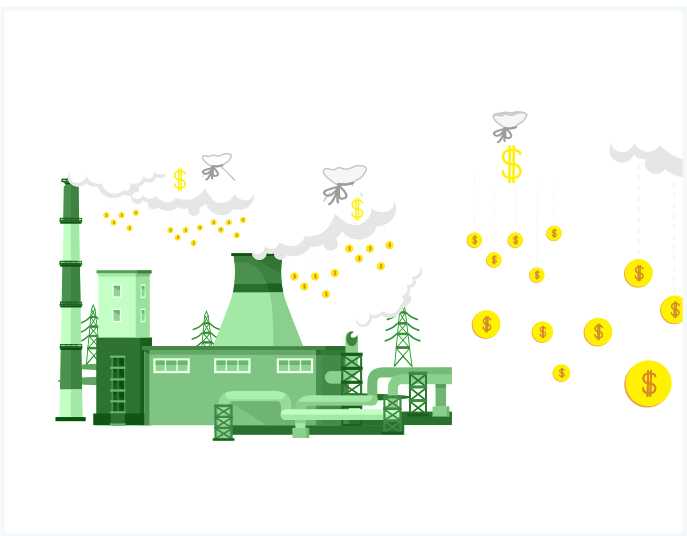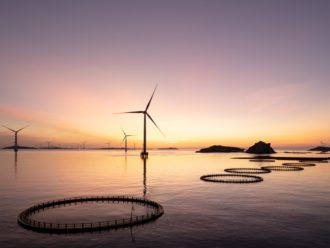A staggering $93trn of investment is required by 2030 to limit global warming to 2°C. This, writes Emma Cusworth, creates an enormous opportunity for investors.

“These sectors [energy; water; waste and recycling; and food and agriculture] are where the greatest opportunity for growth exist.”
Scott Thompson, Impax Asset Management
The discovery of gold nuggets in the Sacramento Valley in 1848 sparked one of the most influential events to shape the American economy during the second half of the 19th century. The Gold Rush attracted thousands of prospective miners in search of opportunity, who collectively extracted around $2bn of the yellow metal – the equivalent of around $60bn in today’s terms – and gave rise to a new sort of economy.
Today, another major economic transition is getting under way. As the risks associated with climate change have gathered both scale and recognition, the transition to a low-carbon economy could spark another gold rush, but this time the stakes are much higher. According to the New Climate Economy, a total of $93trn of investment is required across the whole economy by 2030 to limit global warming to 2ºC. The COP21 agreements are aiming at closer to 1.5ºC.
To date, institutional investors’ interest in climate change has primarily been driven by the need to manage risk – to avoid the negative consequences of stranded assets, for example. However, with such a sizeable transition comes an enormous opportunity for investors to add value to investment portfolios as the Carbon Rush unfolds. And some of the most lucrative opportunities may not be in the most obvious areas.
FROM RISK TO OPPORTUNITY
“It is a natural process to first think about things in terms of risk,” says Faith Ward, chief responsible investment and risk officer at the £3bn Environment Agency Pension Fund (EAPF). “That is the language we speak in, but the opportunity set is increasingly seen as part of the picture. We actively seek out these opportunities, and encourage our managers and other investors to do so as well.”
The focus on risk is completely understandable. According to the Risky Business Project – founded by former New York City mayor Michael Bloomberg, former US Secretary of the Treasury Hank Paulson, and hedge fund guru Tom Steyer – the financial toll from rising seas, steadily increasing heat, and more frequent and extreme storms “will likely add up to hundreds of billions of dollars in direct costs to both the public and private sectors over the coming decades”.
Their research focuses on the US economy alone. Globally, the risk is magnified manifold and, as Risky Business points out, with every year that goes by without reductions in green house gas emissions, the likelihood and magnitude of future climate impacts increase. Interestingly, funding the transition to a low-carbon economy does not necessary require a bigger commitment than previously lucrative economic transformations. Neither does it rely on what Hank Paulson calls ‘an energy miracle’. Existing clean technologies should be sufficient to reduce climate risks.
Funding the transition in the US alone will require around $200bn per year until 2030 and $400bn annually thereafter until 2050. This is not, however, massively out of step with the scale of investment seen in other transformative industries. Investment in computers and software has been around $350bn a year, for example. The collective wealth created by those sectors alone over the last decade proves that massive value can be derived from this kind of economic revolution, which also presented significant risks to the established products and processes in their early days.
PIPES, WIRES AND CABLES
The transition to a low-carbon economy, and therefore the fruits of the Carbon Rush, are likely to focus on four key areas: energy; water; waste and recycling; and food and agriculture. “These sectors are where the greatest opportunity for growth exists,” according to Scott Thompson, who heads institutional sales at Impax Asset Management. Within these sectors he points to energy efficiency in particular as offering “one of the biggest opportunities” for investors.
Elisa Vergine, senior ESG analyst at Candriam, quite rightly points out: “The least polluting source of energy, and the cheapest, is the energy that is not being produced.” In other words, energy that isn’t generated costs nothing and doesn’t create CO2 emissions.
Lauren Compere, director of shareholder engagement at Boston Common Asset Management, says: “The biggest opportunity for investors is around decreasing demand and driving down energy costs, such as investing in technologies and services that make products and process more efficient.”
Energy wastage is a key issue, not just in terms of over-production, but also in terms of leakage. Impax’s Thompson says, in some instances, up to 50% of energy can be lost during transmission. Because energy is not generally produced where it is ultimately needed, this presents a sizeable efficiency problem, and a significant
opportunity for investors.
Storage and transmission infrastructure and technology, in particular, are a key growth area in the transition to a low-carbon economy. They may also offer potentially better risk/reward metrics than the more obvious, established low-carbon investments institutions have typically favoured to date.
As International Public Partnerships (INPP) CEO Giles Frost says: “Storage, transmission and distribution – which are just, if not more important, than generation – are areas that tend to be less well understood by investors. This is where spending serious time really understanding the technology can pay off in identifying high quality, high returning, low-risk investments.”
Since 2006, INPP has achieved a 9.5% annualised return, or just under 140% in total. The fund, which invests in infrastructure assets, benefits from “predictable underlying revenue, being public sectorbacked, typically agreed at the outset and either availability-based or regulated by a government entity with in-built inflation protections”, according to its August 2016 factsheet.
FROM POLICY TO ECONOMIC IMPERATIVE
Public backing naturally provides investors with a greater degree of certainty, thus reducing the risks associated with low-carbon investments. However, given the scale of cost savings available through energy efficiency, the economic, rather than political, drivers are becoming more important as an engine for growth of many companies offering low-carbon technologies and services.
Risky Business projects that the potential fuel cost savings resulting from the transition to a low-carbon economy could add up to $700bn per year between 2040 and 2050 in the US alone, dwarfing the required investment funding needed to achieve this.
Companies that can help deliver those cost savings will enjoy strong economic tailwinds as they deliver improved margins to businesses along the full length of supply chains.
This is already becoming evident. Companies providing solutions for the transition to low-carbon economies are generally delivering superior growth, according to Impax. Thompson says these companies, which tend to be small and mid-cap stocks, “continue to grow 3% to 5% faster than the broader equity market”. “In a low-return environment, they can offer the opportunity of capital growth,” he says.
Furthermore, because these are smaller stocks, there may be an informational advantage available to those willing to put in the right research. Many investors are missing these opportunities, which may be either absent or under-represented in portfolios, simply because they are not well covered by sell-side banks, which have cut their research capabilities since the financial crisis. While this places greater emphasis on stock selection and due diligence, the fundamental economic drivers for the sector remain strong.
CLEAN ENERGY SUPERSEDES POLICY DIRECTION
Candriam’s Vergine says: “Power generation from renewables has already become competitive in some countries and the unit cost of producing electricity from wind and solar has been reduced by 26% and 61% respectively between 2010 and 2016, becoming more competitive than coal in some countries. Scarcity of some natural resources already poses a threat to the continuity of corporate activity. Uncertainty is the ground for opportunity.”
A report from the US Department of Energy shows net electricity generation from coal dropped 53% between 2006 and 2016. Generation from utility-scale solar facilities, by contrast, increased 5000% while solar, wind and natural gas are expected to provide the majority of new power sources. With the public policy direction less clear in the US (and arguably in the UK as Theresa May abolished the Department for Energy and Climate Change), the ability of low-carbon solution providers to supersede the policy or environmental agenda and rely instead on economic drivers based on improving margins across the supply chain, should assure their continued growth.
As Harry Humphreys, impact fund advisory at ClearlySo, says: “Until last summer, the policy direction was moving in the right direction, but both Trump and Theresa May have taken steps that could prove to be a huge backward step in our ability to reach the targets set out in the Paris agreement. “However, regardless of Trump’s views on climate change and how he might alter
policy,” Humphreys continues, “if investment capital is going into clean tech, the US government is going to let that play out.”
EFFICIENT PROPERTY
The economic imperatives of energy efficiency are also creating opportunities in the building sector. Buildings are one of the biggest consumers of energy, accounting for around 40% of total US energy demand, for example.
Impax’s Thompson points to pressures from policy and tenants for greater cost efficiency from existing building stock, which, he says, can be retrofitted with better insulation and energy efficiency measures, and then resold at a premium. “The UK’s building stock, in particular, is quite archaic,” he says, “and prices have come off since the Brexit vote, which has created some very interesting value opportunities to buy buildings, improve their energy efficiency and then sell them on.”
The transition to a low-carbon economy continues to gain momentum and, as the sector matures, the economic tailwinds continue to gather force. This provides strong support for some of the less-well understood opportunities arising from the transition, which investors are increasingly able to exploit and which can offer much sought-after returns in today’s low-return environment.
But the gains won’t just be purely financial. While the Gold Rush wreaked havoc on the landscape, the Carbon Rush should do the exact opposite, creating wealth for generations of savers, but leaving the environment in a better state than it started.
As INPP’s Frost says: “Economic sustainability and environmental sustainability go hand in hand.”
AGRICULTURE: RIPE FOR REVOLUTION
Where megatrends connect, powerful themes emerge – so says Pictet Asset Management – and nowhere is this more prevalent today, than in agriculture. Not only is agriculture by far the most carbon and resource-intensive industry, the world will have roughly 1.5 billion more people to feed in 30 years’ time.
Meanwhile, both governments and consumers are demanding higher quality food. Yet, climate change means the availability of fertile soil is rapidly reducing – by the equivalent of 30 football pitches a minute. The industry is ripe for revolution and investors can exploit the opportunities presented by the convergence of these long-term megatrends.
“Sustainable intensification is needed to increase the output level from the same amount of land while decreasing the environmental impact,” says Pictet agriculture fund manager, Gertjan van der Geer. “Technical innovation is improving quality and efficiency across the food chain.”
Hydroponics is one such innovation, which has enabled not just higher output per unit of land, but also better quality and highly efficient supply chains. Pictet cites the example of a Whole Foods supermarket in New York, above which vegetables are grown using soil-less farming techniques in roof-top greenhouses. The system produces up to 30 times more crops than traditional techniques, but uses 10 times less water, requires fewer pesticides and chemicals due to better disease control, and allows for year-round harvests.
Identifying and exploiting opportunities such as these, which are supported by long-term mega trends that will act as powerful forces for change across business, economy and society, present a long-term investment opportunity that should also enhance portfolio durability.



